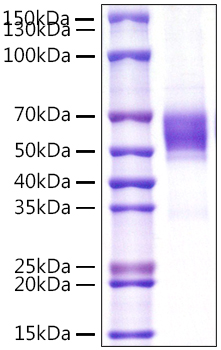Description
Recombinant Human NKG2-D/KLRK1/CD314 Protein
The Recombinant Human NKG2-D/KLRK1/CD314 Protein is a biologically active recombinant protein that plays a significant role in various cellular processes and signaling pathways in human biology. This protein is widely employed in immunological research, cell biology studies, protein-protein interaction analyses, and therapeutic development, providing researchers with a reliable tool for investigating NKG2-D/KLRK1/CD314 function and its implications in health and disease.
This product (SKU: RPCB1569) is produced using HEK293 cells and features a N-Rabbit Fc tag for convenient detection and purification. The protein exhibits a calculated molecular weight of 42.29 kDa with an observed molecular weight of 50-70 kDa under denaturing conditions, achieving ≥ 95 % as determined by SDS-PAGE.. Functional bioactivity has been validated through rigorous quality control assays, confirming its suitability for demanding research applications.
Key Features
| High Purity by Affinity Chromatography | |
| Mammalian & Bacterial Expression Systems | |
| High lot-to-lot consistency via strict QC |
| Product Name: | Recombinant Human NKG2-D/KLRK1/CD314 Protein |
| SKU: | RPCB1569 |
| Size: | 10 μg , 20 μg , 50 μg , 100 μg |
| Reactivity: | Human |
| Synonyms: | KLRK1, CD314, D12S2489E, KLR, NKG2-D, NKG2D |
| Tag: | N-Rabbit Fc |
| Expression Host: | HEK293 cells |
| Calculated MW: | 42.29 kDa |
| Observed MW: | 50-70 kDa |
| Gene ID: | 22914 |
| Protein Description: | High quality, high purity and low endotoxin recombinant Recombinant Human NKG2-D/KLRK1/CD314 Protein (RPCB1569), tested reactivity in HEK293 cells and has been validated in SDS-PAGE.100% guaranteed. |
| Endotoxin: | < 0.1 EU/μg of the protein by LAL method. |
| Purity: | ≥ 95 % as determined by SDS-PAGE. |
| Formulation: | Lyophilized from a 0.22 μm filtered solution of PBS, pH 7.4. |
| Bio-Activity: | Measured by its binding ability in a functional ELISA. Immobilized human MICA (RPCB0286) at 2 μg/mL (100 μL/well) can bind NKG2D with a linear range of 0.61-205.43 ng/mL. |
| Reconstitution: | Centrifuge the vial before opening. Reconstitute to a concentration of 0.1-0.5 mg/mL in sterile distilled water. Avoid vortex or vigorously pipetting the protein. For long term storage, it is recommended to add a carrier protein or stablizer (e.g. 0.1% BSA, 5% HSA, 10% FBS or 5% Trehalose), and aliquot the reconstituted protein solution to minimize free-thaw cycles. |
| Storage: | Store at -20℃.Store the lyophilized protein at -20℃ to -80 ℃ up to 1 year from the date of receipt. After reconstitution, the protein solution is stable at -20℃ for 3 months, at 2-8℃ for up to 1 week. |
KLRK1 (Killer Cell Lectin Like Receptor K1) is a Protein Coding gene. NKG2D, also known as CD314, is an immune receptor that consists of two disulfide-linked type II transmembrane proteins with short intracellular proteins incapable to transduce signals. To transduce signals, NKG2D needs adaptor proteins and it uses two adaptor proteins, DAP10 and DAP12. These two adaptor proteins associate as homodimers to NKG2D- therefore the entire receptor complex appears as a hexamer. NKG2D can send co-stimulatory signals to activate CD8 T cells. NKG2D also plays an important role in viral control. Cellular stress can induce ligands for NKG2D which results in the cell susceptible to NK cell-mediated lysis.








